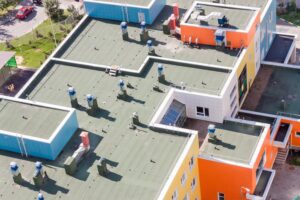
Flat roofing systems are a popular choice for commercial buildings in Germantown. They offer several advantages, including durability, cost-effectiveness, and space utilization. In this article, we will explore the key features of flat roofs, the materials used in their construction, the benefits they provide, the installation process, maintenance and repair tips, and how to choose a reliable flat roofing contractor in Germantown.
Understanding Flat Roofing Systems
Flat roofing systems are characterized by their horizontal or nearly horizontal design. Unlike pitched roofs, which have a slope, flat roofs have a slight pitch to ensure proper drainage. They are commonly used in commercial buildings due to their practicality and efficient use of space.
Flat roofs have been used for centuries in various parts of the world, with evidence of their existence dating back to ancient civilizations. In regions with arid climates, such as the Middle East, flat roofs were traditionally constructed using materials like clay, mud, or stone. These materials provided insulation from the heat and were readily available in the local environment.
Key Features of Flat Roofs
Flat roofs have several key features that make them suitable for commercial buildings, including:
- Low maintenance requirements
- Easy access for HVAC systems and other rooftop equipment
- Ability to create additional outdoor space, such as rooftop gardens or recreational areas
- Enhanced energy efficiency through the installation of insulation and reflective coatings
Additionally, flat roofs offer a sleek and modern aesthetic that complements contemporary architectural designs. Their clean lines and minimalistic appearance contribute to the overall visual appeal of a building, making them a popular choice for commercial properties seeking a sophisticated look.
Materials Used in Flat Roofing
Flat roofs can be constructed using various materials, each with its own set of advantages and considerations:
- Single-ply membranes, such as EPDM or TPO, offer durability and flexibility, making them ideal for a wide range of climates.
- Built-up roofing (BUR) systems, which consist of multiple layers of asphalt and felt, provide excellent waterproofing and insulation properties.
- Metal roofing, including materials like aluminum or steel, is known for its longevity and resistance to harsh weather conditions.
- PVC membranes are lightweight and easy to install, making them a cost-effective option for flat roof construction.
When selecting a roofing material for a flat roof, it is essential to consider factors such as budget constraints, local climate conditions, and the desired lifespan of the roof. Proper maintenance and regular inspections are also crucial to ensure the longevity and performance of a flat roofing system.
Benefits of Commercial Flat Roofing
Commercial flat roofing offers several benefits over other roofing systems:
Space Utilization and Accessibility
Flat roofs provide additional usable space on top of the building. This space can be utilized for various purposes, such as outdoor seating areas for restaurants or storage space for HVAC equipment. Additionally, the flat surface of the roof allows for easy access during maintenance and repair work.
Moreover, the extra space provided by flat roofs can also be used for the installation of solar panels, creating an opportunity for businesses to generate their own renewable energy and reduce their carbon footprint. This utilization of rooftop space for sustainable energy production showcases the versatility and environmental benefits of commercial flat roofing.
Cost-Effectiveness and Energy Efficiency
Flat roofs are cost-effective compared to pitched roofs because they require fewer materials and less time to construct. They also provide excellent insulation, reducing heating and cooling costs. Additionally, the installation of reflective coatings can further enhance energy efficiency.
Furthermore, the design of flat roofs allows for the easy integration of green roof systems, which involve the installation of vegetation on the roof surface. Green roofs not only enhance the energy efficiency of the building by providing natural insulation but also contribute to improved air quality, reduced urban heat island effect, and increased biodiversity in urban areas. The cost savings from reduced energy consumption and the environmental benefits of green roofs make commercial flat roofing a sustainable choice for businesses looking to minimize their ecological impact.
Installation Process of Flat Roofs
Proper installation is crucial for the longevity and performance of a flat roof. The process involves several steps:
Pre-Installation Considerations
Prior to installation, the existing roof should be thoroughly inspected for any damages or leaks. Any necessary repairs should be made to ensure a solid foundation for the new roof. Additionally, the appropriate materials and drainage systems should be selected based on the building’s specific requirements.
It is essential to consider the climate and weather conditions of the area when choosing materials for a flat roof. For instance, in regions with heavy rainfall, a robust waterproofing system is imperative to prevent water infiltration. On the other hand, in areas prone to high temperatures and UV exposure, selecting materials with excellent heat resistance and UV protection is vital to prolong the roof’s lifespan.
Step-by-Step Installation Guide
The installation process typically includes:
- Preparing the roof surface by cleaning it and removing any debris.
- Installing the underlayment or base layer to provide a waterproof barrier.
- Applying the selected roofing material, ensuring proper overlap and fastening.
- Creating proper drainage systems to prevent water pooling.
- Installing edge flashings and other accessories to ensure a watertight seal.
During the installation of the underlayment, it is crucial to pay attention to detail to avoid any gaps or overlaps that could compromise the waterproofing of the roof. Proper adhesion and sealing of the underlayment are essential to prevent water seepage and ensure the roof’s integrity. Additionally, when applying the roofing material, professionals must follow manufacturer guidelines to guarantee a secure and durable installation that can withstand various weather conditions.
Maintenance and Repair of Flat Roofs
Maintaining a flat roof is essential for maximizing its lifespan and preventing costly repairs. Regular inspections and maintenance are recommended.
Regular Inspection and Maintenance Tips
Inspect the roof at least twice a year, ideally in the spring and fall, and after severe weather events. Look for signs of damage or deterioration, such as cracks, blisters, or loose flashing. Clean the roof surface regularly to remove debris and clear the drains to prevent water ponding.
Identifying and Addressing Common Roof Problems
Common issues with flat roofs include leaks, ponding water, and membrane damage. It is important to address these problems promptly to prevent further damage to the building’s interior. Hiring a professional roofing contractor for repairs is recommended to ensure proper assessment and long-lasting solutions.
Choosing a Flat Roofing Contractor in Germantown
When selecting a flat roofing contractor in Germantown, consider the following factors:
Factors to Consider When Hiring a Contractor
- Experience and reputation
- Licensing and insurance
- References and portfolio of past projects
- Warranty offerings
- Compliance with local building codes and regulations
Ensuring Quality Workmanship and Service
To ensure quality workmanship and service, request detailed proposals from multiple contractors, compare their estimates, and ask for references. It is also advisable to check online reviews and ratings. Choosing a reputable contractor will minimize the risk of subpar workmanship and potential issues in the future.
In conclusion, Germantown commercial flat roofing offers several advantages, including space utilization, cost-effectiveness, and energy efficiency. Understanding the key features, materials used, installation process, and maintenance requirements is essential for maximizing the lifespan of a flat roof. By selecting a reliable contractor and following proper maintenance guidelines, commercial building owners can ensure the long-term durability and performance of their flat roofs.
Ready to secure your Germantown commercial property with a flat roofing system that promises durability and superior protection? Look no further than Commercial Roofing Rana. With our extensive experience serving the Mid-South since 1983, we specialize in providing top-tier roofing services tailored to a variety of commercial buildings, from industrial complexes to shopping centers. Trust in our licensed professionals and the precision of our Duro-Last roofing systems to safeguard your business against the elements. Don’t let water damage threaten your investment. Schedule Now! and let Commercial Roofing Rana deliver the exceptional service and results your property deserves.
